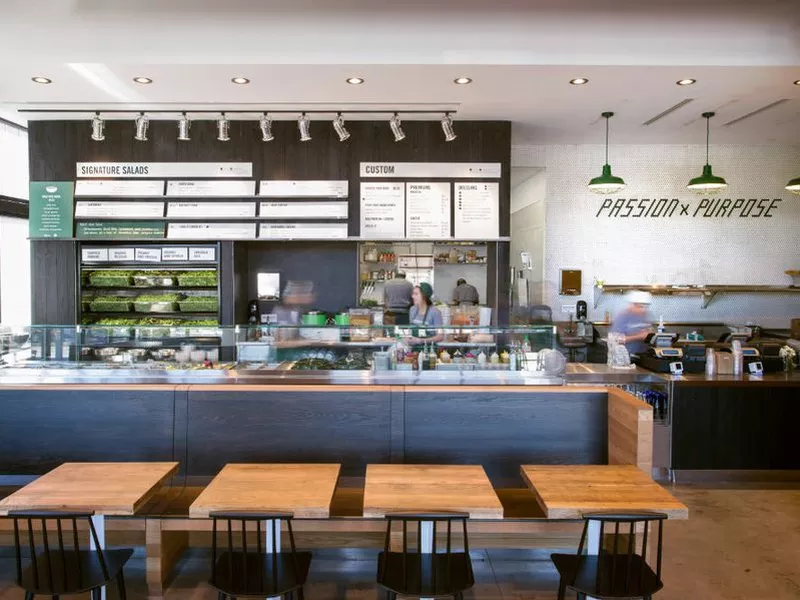Sweetgreen’s Winning Recipe
Sweetgreen's attention to detail and strategic alignment is paying dividends for the fast causal startup.
![]() Fast causal is one of the most competitive and fast growing segments in the food industry. In order for a company to succeed in this fiercely competitive landscape, it needs to ensure that its business and operating models are aligned. Sweetgreen, a Washington, DC based salad chain with over $100M in venture funding, is disrupting the $5 trillion dollar food industry by relentlessly pursing this alignment, ensuring that its operating model can repeatedly satisfy the companies business goals. [i]
Fast causal is one of the most competitive and fast growing segments in the food industry. In order for a company to succeed in this fiercely competitive landscape, it needs to ensure that its business and operating models are aligned. Sweetgreen, a Washington, DC based salad chain with over $100M in venture funding, is disrupting the $5 trillion dollar food industry by relentlessly pursing this alignment, ensuring that its operating model can repeatedly satisfy the companies business goals. [i]
Business Model-
“Sweetgreen is a destination for delicious food that’s both healthy for you and aligned with your values. We source local and organic ingredients from farmers we know and partners we trust, supporting our communities and creating meaningful relationships with those around us. We exist to create experiences where passion and purpose come together.”[ii] The company uses sustainability, health, speed, and community to attract customers to its 30 plus locations.[iii]
Sweetgreen’s operating model is fully aligned with the companies’ business model.
Operating Model:
- Human Capital– The company attracts passionate workers that are proud to identify themselves as Sweetgreen employees. They maintain this talent by paying their workers slightly more than fast causal competitors ($10.15 an hour) and by providing free meals every shift.[iv] Sweetgreen also ensures that all employees understand their operational model. All employees from top-level executives to backend finance employees must work on the Sweetgreen assembly line as part of their onboarding process.[v] watch the video
- Quality– Sweetgreen sources its food from local farmers and changes its menu consistently to take advantage of the seasonality of certain ingredients. The only physical barrier that separates the food from the customer is a thin glass divider, signaling to customers that the company is proud of their food and has nothing to hide. The visibility in the operational process appeals to millennial consumers who like to understand where their food comes from and how it’s assembled.
- Speed– Sweetgreen replicated Chipotle’s assembly line model but occasionally incorporates slight modifications. Similar to Chipotle, Sweetgreen has a line of employees standing shoulder-to-shoulder building certain parts of a customer’s meal. What differentiates Sweetgreen’s operational model from Chipotle’s, is that occasionally a single employee will travel down the assembly line completing each aspect of a customer’s salad. This rarely occurs when the restaurant has a long line, but during quieter periods it is extremely common. Sweetgreen abandons the assembly line model because the founders believe that if an employee travels down the assembly line with the customer, they will have time to create a dialogue and connect with the consumer. This coincides with Sweetgreen’s mission to create meaningful relationships with their customers. [vi]
- Technology– The company leverages the latest technology to increase speed and customer loyalty. Sweetgreen offers an application to place orders and pay without entering the confines of the store. [vii]
- Real Estate– Sweetgreen’s store infrastructure and real estate selection is one of the true differentiators in their operating model. The company’s founders carefully select locations and infrastructure that don’t need significant renovation to align with their mission to be environmentally conscious. More important to the operations of their business is the utilization of floor space. Since meals are made in front of customers, Sweetgreen does not need a large kitchen or expensive culinary machines. The lack of capital investment and physical infrastructure contributes to Sweetgreens impressive profit margin.[viii]
- Culture– Outside of their traditional salad business, Sweetgreen also organizes a music festival called SWEETLIFE that showcases some of the most popular artists including Calvin Harris, Kendrick Lamar, The Weekend, and Vance Joy.[ix] Photograph’s of these events are strategically hung where lines build up in their in store locations. These photographs constantly remind Sweetgreen’s customers that by eating at Sweetgreen they are doing much more than consuming a salad.
As Sweetgreen continues to scale, the company needs to be careful not to sacrifice their unique ability to align their business and operating models. Their attention to detail and strategic alignment in their early years has positioned them well to challenge more established players such as Chipotle and Panera Bread.
[i] http://www.cbsnews.com/videos/how-sweetgreen-is-redefining-healthy-fast-food/
[ii] http://sweetgreen.com/our-story/
[iii] http://www.entrepreneur.com/article/239924![]()
![]()
[iv] http://money.cnn.com/2015/07/10/investing/sweetgreen-brand-next-chipotle/
[v] Employee interview conducted on 12/1/15
[vi] http://www.phillymag.com/be-well-philly/2015/10/15/sweetgreen-rittenhouse-philadelphia/#gallery-2-2
[vii] http://sweetgreen.com/
[viii] http://blogs.wsj.com/venturecapital/2013/12/04/steve-cases-revolution-invests-22m-in-sweetgreen-salad-shop/
[ix] http://sweetlifefestival.com/
[x] https://seatgeek.com/tba/festivals/sweetlife-festival-tickets-tour-dates-schedule-lineup/




Thanks for the great post! I had lunch at Sweetgreens for the first time on Friday and I was surprised to see a line of customers out the door at 2pm in the afternoon. Definitely seems like a popular spot. As a customer, I was impressed by the seasonal menu and the fact they had a blackboard with the names of the farms where they source meat and some of the veggies. I’m curious if the sources of ingredients are different between Sweetgreen locations currently (like D.C versus Boston). How do you think they will be able to scale the local ingredients/seasonal menu aspect of the operating model? Most fast-causal chains rely on consistency between locations, so Sweetgreens may have a challenge expanding with a model that encourages differences between stores.
Great point Maggie. I initially had the same concerns around scale. However, as the company scales the more leverage they will have in negotiating lower prices for higher quality food because they are great source of revenue for these local food producers. However, I do think they have to continue to be careful picking locations that are close proximity to family farms.